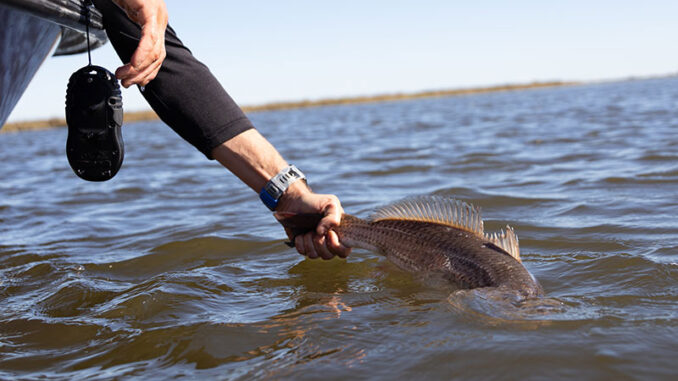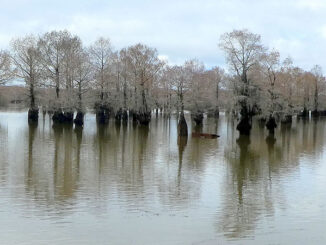
As we look back, Louisiana fishermen (coastal fishermen that is) can color the month red — as in the bright red of a red snapper and the reddish-gold of a redfish. And that’s no April Fools.
Finally, after six months of wrangling over a single fish in the daily creel, Louisiana has settled in on a redfish management plan that might check at least most of the boxes in a strategy to restore this species to numbers state biologists believe will keep future generations with a healthy redfish population.
It’s also possible, by June 20, Louisiana coastal anglers will a new set of redfish regulations.
Passed by the Louisiana Wildlife and Fisheries Commission in early March, the 18-27 inches “slot” limit with a four-fish-per-day creel limit is exactly what state fisheries managers offered six months ago in October, 2023.
Wrangled through a mix of ideas some commission members believed would have redfish stocks recover sooner, offerings of new redfish plans got kicked back via Legislative oversight — a commission-amended plan lowered the daily creel to three fish, and so did a once-proposed 18-24 inches slot limit.
It must be noted how many added support for the three-fish limit during public comment sessions, even before the commission’s March meeting’s vote — all the while knowing the State Legislature’s Natural Resources Committee’s opposition to that cut of two fish from the current five-per-day limit.
A final plan, finally
So, now we have it: a final plan, a set of rules that included banning keeping a redfish measuring more than 27 inches, and prohibiting charter skippers and whatever crew they have aboard from keeping any redfish while on a chartered trip.
There are some opposed to the new regs.
That’s to be expected: change is never easy, but if we are to accept our state biologists’ data that Louisiana is not allowing enough redfish to “escape” inshore and nearshore waters to join the breeding stock, then we must accept change.
Maybe the six months of redfish discussion benefited from the five-year jawing over our need to reduce the speckled trout limits. Those five years were about two too many years to arrive at new trout size and creel limits.
What’s lost in the discussions of these two popular recreationally targeted species is the biology of these two fish.
Speckled trout have a life span of less than 20 percent of a redfish, a species which can live as long as 50 years.
Some female speckled trout can spawn as early as one year old and certainly by age 2. It takes as long as five years for a female redfish to enter the spawning cycle.
So, a female trout might lay eggs for 5, 6 maybe 7 years max, while a female redfish could carry eggs for 25-35 years.
Sure, trout spawn much more often during a spring-summer cycle than do redfish. Several fisheries biologist have said a mature speckled trout female can deposit as many as 20 million eggs in one year. And, like former LSU baseball coach Skip Bertman often said, “That’s a lot.”
Years ago, in the late 1980s, when purse seining redfish put a crimp in the population — blackened redfish was the craze — LSU professor Richard Condry said redfish are so fertile that, under the right conditions, he could repopulate Louisiana’s marshes with 10 adult female redfish. True, it would take time, but, he said, it could be done.
So, the concerns about which redfish recovery plan would achieve the best results — more precisely the quickest result — a five-year recovery plan for speckled trout is much shorter than a 26-year plan to restore redfish to “healthy” numbers. But the biological truth appears to be five years for a fish with a life span up to eight years is good, and 26 years for a fish with a life span of 50 years also is acceptable.
Unlike the new speckled trout plan, there is no “sunset” provision in this new redfish management regime. State fisheries biologists plan an extensive review of the redfish stocks in five years, because that’s about how long it takes for a hatchling to grow big enough to enter the spawning stock.
An extensive speckled trout study is planned for sometime in 2026-2027.
After both assessments, we should have a better handle on whether, or not, these new management plans are working in our coastal waters.
And when it comes to protecting specks and reds, sportsmen can’t give up on the push to find out the facts about just how much damage is done by pogie boats, still operating in Louisiana with by far the most casual regulations of any Gulf state.
Early snappers
Offshore fishermen won’t have much time to get ready for the new private recreational red snapper season.
It’s been moved up from what was a traditional Friday before Memorial Day to April 15 this year.
The season will begin with a four-red snapper daily limit, a holdover from the last half of the 2023 season, along with a seven-day-a-week season and the 16-inch minimum size remain.
The move was prompted by the 2023 take, an effort by our state’s private recreational fishermen that fell 56,123 pounds short of the state’s 934,587-pound annual allotment.
The 2023 season ran until Dec. 31. At 220 days, it was the longest red snapper season since the days federal managers imposed extraordinarily stringent rules on taking red snapper by the recreational sector.
The only concern about moving the season up five weeks was that the 934,587-pound quota could be caught before the Labor Day weekend, which would close summer’s last holiday to red snapper action.
A check of 2023 landings — according to LA Creel survey data — showed recreational landings between Labor Day and Dec. 31 would, when added to the 56,123-pound shortfall, give fishermen 167,294 pounds to take in the period between April 15 and May 24, which was a closed season last year.
So, the Labor Day concern might not come to pass, but only if 2024 weekly catches estimated by LA Creel are similar to 2023, a year when Louisiana’s offshore guys, gals and kids didn’t contend with tropical storms or hurricanes.
We can only hope — and pray.


